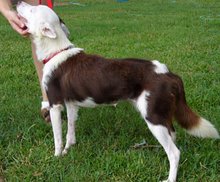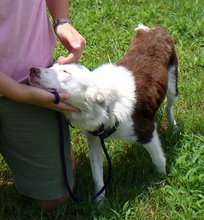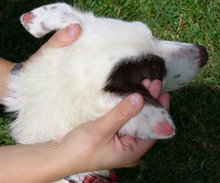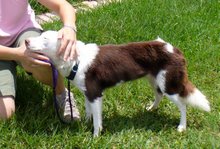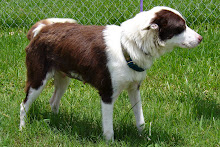Ruby's already due for her second heartworm treatment next week, and surprisingly enough the month has passed quickly. Ruby has WAY more energy than any of us expected, so it's been a challenge to find ways to expend her energy but stay safe. Overall she's been a good patient, she's only taken out her frustrations on a squeaky toy once or twice!
I've been wearing her out by making her brain tired. She has to earn every piece of kibble she gets in a day (and Ruby LOVES her food!). She's always watching the household activities carefully, just in case there's a good chance she's going to get a piece of kibble or two. I've caught her more than a few times plopping her rear on the floor anytime I walk near her pen in the kitchen, as if to say, "Hey! Look at me, I'm sittttinnngg! Kibble please!" (of course it works). She's also been practicing sitting for petting, and this is truly her FAVORITE part of training time (no food, but there's PETTING, woo hoo!). She's getting the hang of "down" and "wait" (food involved here too). The biggest news of all is that she'll "wait" to eat her sardines until she's told, good girl! Ruby's also learning how to take a few steps on her leash and then sit nicely when I stop moving. This has proved to be a good game for her. She likes to bust out of her crate in a mad frenzy, NOT a good idea when you need her to be still and quiet! This way she gets to move around a little in a slow, controlled manner AND get food for it, too. It takes a few minutes to get to the backdoor to go out, but she really likes that sitting game.
The weather has been very nice lately, so Ruby has been allowed to ride with us in the car to go hang out in her crate with the hatch open to watch me train with the other girls. Ruby tends to bark when others are having fun, but all week long she has been very good and calm and quiet watching us work (yep, you guessed it, more kibble involved). I now have to coax her OUT of the crate in the car instead of worrying about her premature escape. By the end of the evening she's crashed out on the couch, snoring with the rest of them. She's a smart girl, that's for sure.
Fingers crossed the next month of treatment goes just as smoothly.
Death from Distemper or heartworms is not quick, the suffering is immense. There is no cure for Distemper, and any treatment available is only meant to ease suffering or help the dog stay strong enough to attempt to fight the virus on it’s own. Distemper slowly destroys, the lymphoid organs, respiratory organs, gastrointestinal organs, and urogenital organs, one-by-one. Most dogs that die from distemper, die from neurological complications, many of which are horrific to witness: swelling of the brain, seizures, deterioration of mental and muscle function, paralysis, disabling muscle spasms, depression and an increased sensitivity to stimuli like pain or touch. Heartworms is as equally devastating. Read Livy’s story to understand why waiting to see if a dog gets heartworms to take action is not only expensive but very, very dangerous for the dog.
Ruby was very, very lucky to have survived and found a wonderful home to live out a healthy and happy life. Her illnesses were easily avoidable with simple and relatively inexpensive preventive measures. Sadly, heartworm prevention costs only about $7-$10 a month, and the DHLP-P vaccination, which protects against more than just Distemper, costs only about $8-$12 a year. The cost in your time to carry out this prevention is even less. We hope that Ruby’s story (below) and the suffering she had to endure will educate so that other dogs don't have to suffer or die from these preventable diseases.
Ruby was very, very lucky to have survived and found a wonderful home to live out a healthy and happy life. Her illnesses were easily avoidable with simple and relatively inexpensive preventive measures. Sadly, heartworm prevention costs only about $7-$10 a month, and the DHLP-P vaccination, which protects against more than just Distemper, costs only about $8-$12 a year. The cost in your time to carry out this prevention is even less. We hope that Ruby’s story (below) and the suffering she had to endure will educate so that other dogs don't have to suffer or die from these preventable diseases.

May 25: My German Shepherd

May 17: Olivia, Henrietta, Sunshine and Ruby

April 10: First Trip to the Beach














